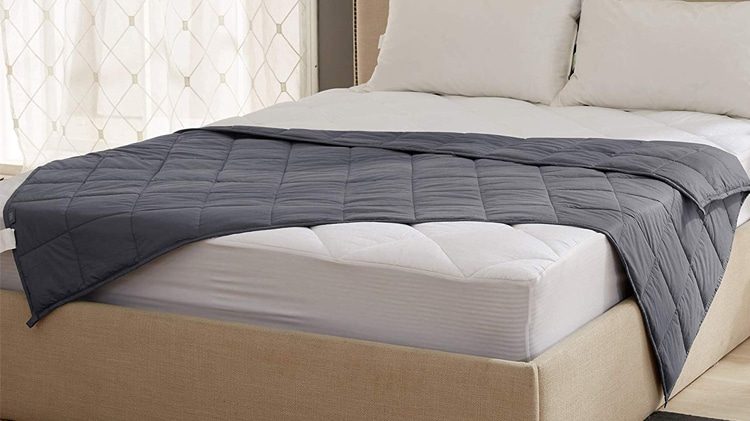On three consecutive occasions at 3 in the morning, Amy caught her 19-year old son in the basement slouched in front of the television as usual, his blank stare suggesting that he really wasn’t tuned in.
Concerned, she asked him why he wasn’t in bed at this hour. He said he couldn’t sleep and asked if she’d get him a prescription for sleeping pills.
Amy said no. She wasn’t about to allow her son to take sleeping pills. She took him to the doctor the next day. After some questions and tests, the doctor diagnosed Jason with post-traumatic stress disorder (PTSD).
PTSD sufferers have access to treatment options to help alleviate their symptoms, various psychotherapies and medications being the most frequently prescribed. However, it seems that only a few are aware that the use of a weighted blanket is one of the safest, non-prescription methods that can help diminish the effects of PTSD.
First, let’s look briefly at PTSD and second, discuss how weighted blankets can help people grappling with this mental problem.
Post-traumatic stress disorder overview
The highly respected Mayo Clinic gives this catch-all description of post-traumatic stress disorder: it is a mental health condition triggered by a traumatic event. The person experiences the situation himself, or witnesses it happening to another person.
The traumatic event can be a single occurrence or one that lasts for weeks and months. Symptoms do not necessarily show immediately; they can manifest themselves long after the trauma took place.
If we continue our fictitious Amy and Jason story above, we can surmise that Jason and his friend had too much to drink at a party, and against the advice of their friends, drove home with Jason at the wheel. When they reached the highway, his driving became increasingly erratic.
He did a sharp swerve to avoid hitting a concrete barrier and within seconds, collided with a van. The impact was such that the front of the car was a heap of shriveled metal. His friend died instantly. Jason came out of the accident unscathed.
After the funeral, Jason was overwhelmed with remorse and guilt. He kept asking, “Why not me?”, “How could I do this to his family?” “Were those extra drinks worth it?”
People who suffer from PTSD have flashbacks (what psychotherapists call “re-experiencing”), recurring nightmares, or anxiety attacks. They have trouble sleeping and have wild mood swings.
Some PTSD sufferers recover with the proper therapies and medication, but others aren’t so fortunate. Their symptoms linger indefinitely and if left untreated, can lead to serious consequences.
Years ago, PTSD was associated with soldiers returning from battle. The torture, deaths, suffering, and human deprivation play on their minds, haunting them incessantly even when combat duty ends, their mental health compromised by the unspeakable ugliness of war.
PTSD treatment options
Treatment options include psychotherapies (an example would be cognitive behavior therapy – also known as CBT), exposure therapy (which can be part of CBT or as a stand-alone treatment approach), medication and support groups.

A point to remember is that not everyone who goes through a traumatic event will suffer from PTSD. Behaviorists explain that there are risk and resilience factors involved.
Some risk factors are childhood abuse, living through dangerous events or trauma, seeing someone get hurt or seeing a dead body; resilience factors, on the other hand, which help reduce the likelihood of developing PTSD are support groups, a positive approach to life, and an effective coping strategy.
Weighted blankets are a wonderul – and welcome – invention. These blankets are now being regarded as a possible add-on to PTSD therapies, some considering it as the simplest and safest solution to the debilitating effects of PTSD.
“Not all wounds are visible” is the motto of The PTSD Journal.
Five ways weighted blankets help PTSD sufferers
Comfort and security – a weighted blanket mimics the benefits of a human hug. When a person is mentally anguished due to past or recent trauma, a weighted blanket can help reduce muscle tension when draped over the body.
Children, for example, calm down when they are held and caressed. The feeling that they are protected reduces their anxiety, a reason why parents buy weighted blankets as a supplement to their kids’ therapy and medication.
For adult sufferers, it is like having a massage and feeling relaxed, luring them to sleep. This physical stimulation promotes serotonin production in the brain which in turn promotes melatonin, a sleep aid.
Decreased insomnia, better quality sleep – the concept of deep pressure touch stimulation (DPTS) is a feature of weighted blankets, making them popular.
“It’s like swaddling a baby,” as it is often described, and these gentle motions of swaddling happen because the stone pellets inside the blanket distribute the weight evenly. Some weighted blankets are made of disks coated with metal.
Reduced anxiety and distress – it can be safely assumed that this benefit is an offshoot of the comfort and security benefit above. Trauma can alienate a person from friends and family. He withdraws from society because he can’t cope adequately.
A person with PTSD can experience anxiety attacks because he feels his life is out of control. Using a weighted blanket promotes feelings of reassurance and a semblance of coping effectively.
Promise of relief – Some PTSD sufferers also experience depression and aggression. Unable to understand and control their reactions to certain situations, they feel sad or angry. When they go to bed with a weighted blanket, it produces feelings of being grounded, of being relieved in the aftermath of a snowstorm.
While a weighted blanket cannot take the place of medication, it is certainly a helpful supplement to prescribed medication or therapy. Speak to your doctor about it.
100% natural remedy – remember Reader’s Digest? Who still reads this 96-year old publication? Up until 2009, it was one of the best-selling consumer magazines in the United States.
A writer for the PTSD Journal said that when it comes to finding natural remedies for stress and anxiety, Reader’s Digest recommended it as the #1 remedy. No one can deny that warm, fuzzy feelings brought about by a weighted blanket add a more human dimension that medications do not provide. Touchy-feely? Most definitely!
Love and compassion
Those who use weighted blankets are seeing changes especially in their sleep patterns. And sleep, like laughter, is usually the best medicine.

People who suffer from PTSD need generous doses of love, compassion, and physical support, but when loved ones can’t be around 24/7, a weighted blanket seems to be the ideal, friendly solution.
Compare it to those individuals who feel safe and comfortable only when someone goes on top of them and hugs them, or seniors who stop feeling agitated when their dog jumps on their lap and stays there, generating a sense of companionship.
Ready to give weighted blankets a try?
Before you go shopping for a weighted blanket, you need to think about:
Weight – while some claim that a weighted blanket should be 15-30 pounds, that may not apply to everyone. Some people can take a lot of weight; some, however, tend to feel hot or feel like they’re carrying a burden. A good rule of thumb is that the blanket should weigh around 10% of your body weight.
Fabric – some fabrics cause allergies so choose carefully. Blankets come in cotton, (both organic and non-organic), flannel, polyester, or polar fleece. Some manufacturers constantly update their fabric choices, adding more options. Find out if the person who has PTSD has an aversion to a specific type of fabric.
Construction – different blanket companies use their own proprietary manufacturing methods, so it is worth your while to find out how the blankets are made.
Care – follow the seller’s instructions on how to care for a weighted blanket. See if there is a warranty period or if they do repairs.
Final word…color
Some PTSD sufferers are sensitive to sights, sounds, or smell because they can bring back memories of the event. Find out what these triggers are.
For example, when choosing a pattern or color of a weighted blanket, find out how the person reacts to them. It is no wonder that color psychology has its rightful place in behavioral therapy.
For example, did you know that red can trigger anxiety and that grey reminds people of their dark moods? Experts say that blue is a mentally soothing color. Soft blues are said to have a calming effect on the mind and promote better concentration.

